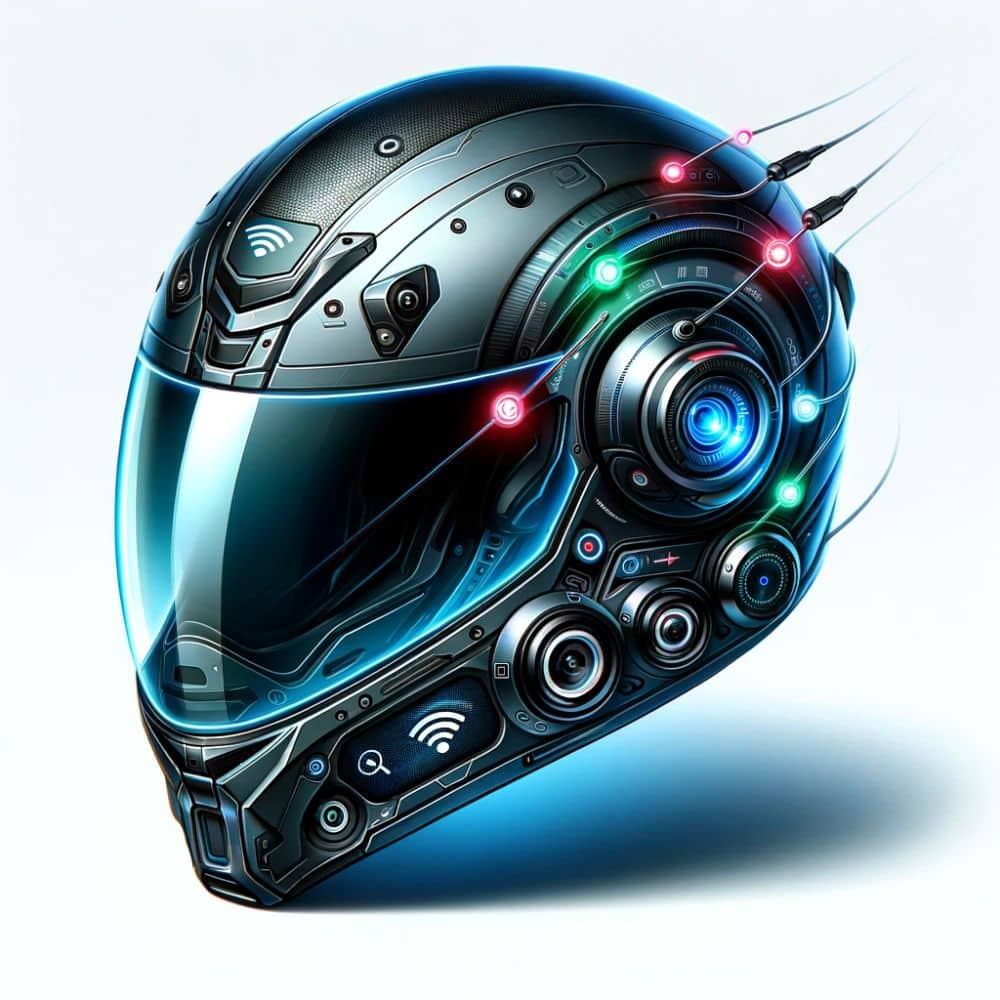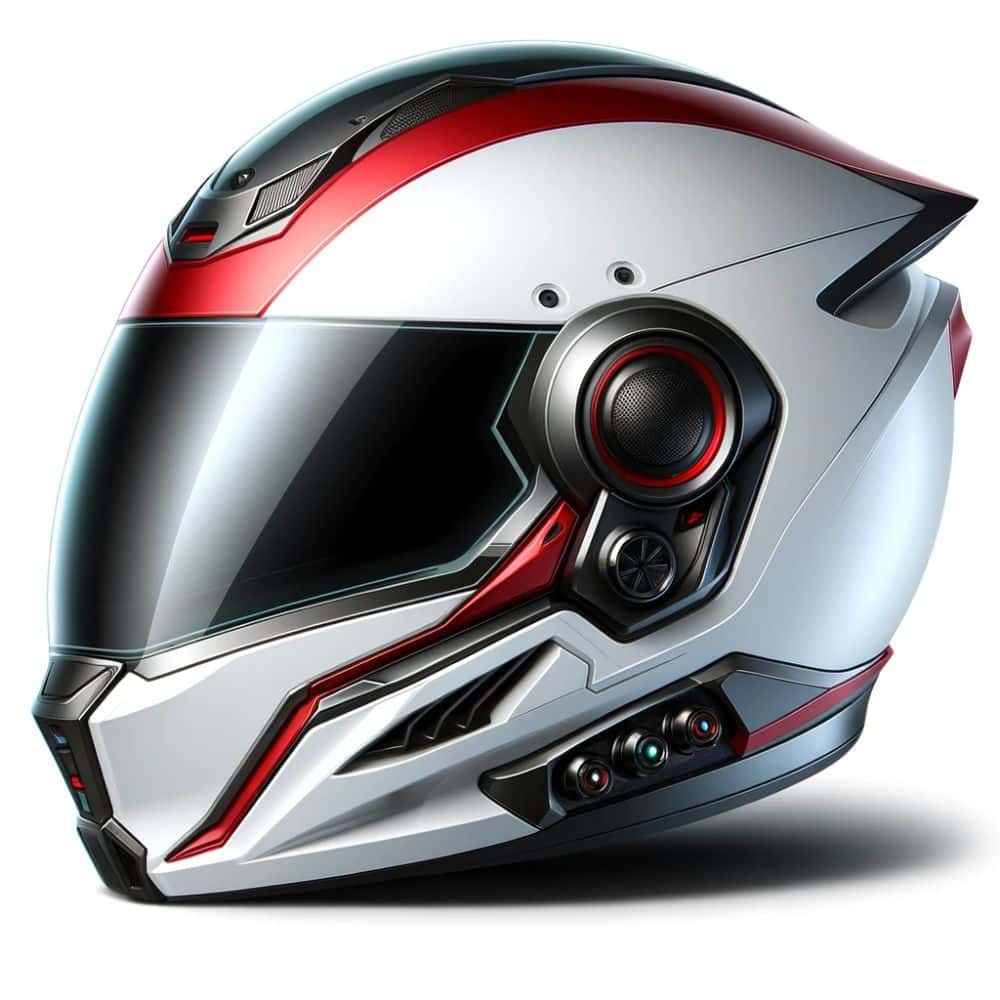Smart helmet technology has marked a significant leap forward in the ever-evolving landscape of motorcycle safety. The industry has responded with innovative solutions as riders seek enhanced protection and cutting-edge features.
This article delves into ten groundbreaking smart helmet technologies reshaping how motorcyclists experience road safety and connectivity. From advanced communication systems to state-of-the-art collision detection, these innovations safeguard riders and enrich the riding experience with smart, intuitive features.
Top 10 Smart Helmet Technology Innovations Transforming Motorcycle Riding Safety
Integrated Heads-Up Display (HUD)
The advent of Integrated Heads-Up Display (HUD) technology in smart helmets is a groundbreaking step in enhancing motorcycle rider safety and convenience. By projecting vital information, such as speed, navigation directions, and important road alerts, directly into the rider’s field of vision, HUD technology dramatically minimizes distractions. This allows riders to maintain their focus on the road without looking away for information.
Additionally, the HUD can display data from the motorcycle’s diagnostics, weather updates, and other customizable information, making it an invaluable tool for urban commuting and long-distance touring. Its implementation promotes safety and adds a futuristic aspect to the riding experience, blending technology seamlessly with the thrill of riding.
Real-Time GPS Navigation

Integrating Real-Time GPS Navigation in smart helmets has transformed how motorcyclists explore and travel. This feature gives riders precise, easy-to-follow directions displayed within their helmet, eliminating the need to stop and consult physical maps or handheld devices. This means a more fluid and uninterrupted riding experience for touring enthusiasts and daily commuters.
The GPS often includes traffic updates, rerouting options, and points of interest, making long trips more efficient and everyday commutes smoother. It’s a significant step towards intelligent mobility, where technology makes travel more intuitive and less stressful.
Built-In Bluetooth Communication
Built-in Bluetooth Communication in smart helmets has significantly enhanced how riders interact with their devices and fellow riders. This technology allows for seamless smartphone connection, enabling hands-free calls, music streaming, and access to voice-assisted functionalities like Siri or Google Assistant. For group rides, this feature facilitates clear communication between riders, fostering a sense of camaraderie and coordination.
A major benefit is the ease of receiving navigational audio prompts and the ability to control music or answer calls without compromising safety. Moreover, this connectivity contributes to a more enjoyable and socially connected riding experience, bringing modern convenience to the forefront of motorcycle technology.
Advanced Impact Detection Systems

Advanced Impact Detection Systems in smart helmets are a leap forward in rider safety technology. These systems employ sophisticated sensors to detect and analyze the severity of impacts during a crash. They are designed to distinguish between minor falls and serious collisions, and in the event of a significant impact, they can automatically send alerts to emergency services with the rider’s location and details about the crash.
This swift communication can be crucial in emergencies, potentially reducing response times and increasing the chances of timely medical intervention. Furthermore, some systems record data vital for accident analysis and improving future helmet designs.
Rear View Camera Integration
Integrating rear-view cameras in smart helmets has significantly advanced rider safety by addressing one of the most common issues: blind spots. These cameras provide a panoramic, real-time view of what’s happening behind the rider, displayed on a small screen inside the helmet or on the HUD. This eliminates the need for frequent over-the-shoulder glances, which can be distracting and dangerous.
The continuous feed from the rear-view camera allows riders to monitor traffic conditions, anticipate potential hazards, and make safer lane changes. It’s particularly advantageous in dense urban traffic and high-speed highway conditions, where situational awareness is crucial.
Voice Command Control
The integration of Voice Command Control in smart helmets is a significant enhancement in the realm of motorcycle technology. This feature allows riders to operate various helmet functions such as communication systems, navigation, and even controlling connected smartphone apps, all through voice commands.
This hands-free operation is crucial for maintaining control and focus while riding. It also adds a layer of convenience, allowing riders to make calls, send texts, or even control their music without lifting a finger. As voice recognition technology becomes more sophisticated, the potential for this feature expands, paving the way for an increasingly interactive and connected riding experience.
Environment Adaptive Visors

Environment Adaptive Visors in smart helmets significantly advance rider comfort and safety. These visors automatically adjust their tint based on the ambient light conditions, ensuring optimal visibility at all times. In bright sunlight, the visor darkens to reduce glare and protect the rider’s eyes, while in low-light conditions, it becomes clear to enhance visibility.
This adaptability is crucial for maintaining a clear view of the road and surroundings and safe riding. Moreover, these visors can adjust to weather conditions, like fog or rain, offering a versatile solution to various riding environments.
Solar-Powered Charging
Solar-powered charging in smart helmets is an innovative step towards sustainable technology in motorcycle gear. Helmets with solar panels use renewable energy to charge the helmet’s electronic features, like communication systems, navigation, and cameras. This reduces reliance on traditional charging methods and ensures that the helmet’s functionalities are always powered, especially during long rides under the sun.
The use of solar power is a forward-thinking approach, aligning with the growing trend of eco-friendly practices in technology. It’s especially appealing to environmentally conscious riders and those undertaking long-distance tours where charging facilities may be scarce.
Noise-Cancellation Technology
Incorporating Noise-Cancellation Technology in smart helmets is a significant advancement in enhancing the riding experience. This technology actively reduces ambient noise, such as wind and road noise, allowing riders to focus more on the road and less on distracting sounds. It greatly improves the clarity of in-helmet communication systems and audio alerts, making them more audible over the roar of the engine and the rush of the wind.
This technology is a boon for long-distance riders, reducing auditory fatigue and making the journey more pleasant. Additionally, it contributes to safer riding, as hearing important sounds like sirens or horns is crucial in traffic.
Emergency Alert Systems
Emergency Alert Systems in smart helmets are a vital safety feature, providing riders an added layer of security. In the event of an accident, these systems automatically detect the crash and send out alerts to predefined contacts or emergency services, including crucial information like the location and nature of the incident. This rapid alert can be lifesaving, particularly when the rider cannot call for help.
Some systems also include features like fall detection and an SOS button for manual activation. These systems provide peace of mind to the riders and their families, knowing that help is more likely to arrive quickly in case of an emergency.

I've diligently categorized my motorcycle gear recommendations into all available categories, with the aim of providing you with a comprehensive analysis that showcases the absolute best options for all your needs. These items are the culmination of in-depth research, extensive testing, and personal use throughout my vast experience of 50+ years in the world of motorcycling. Besides being a passionate rider, I've held leadership positions and offered consultancy services to reputable companies in over 25 countries. To See Top Picks and the Best Prices & Places to Buy: Click Here! |
Information for this article was partially sourced and researched from the following authoritative government, educational, corporate, and non-profit organizations:
- National Institutes of Health | The National Center for Biotechnology Information
- Smarter USA Org | Skilled Motorcyclist Association
- Integrated Heads-Up Display (HUD)
M/TP













